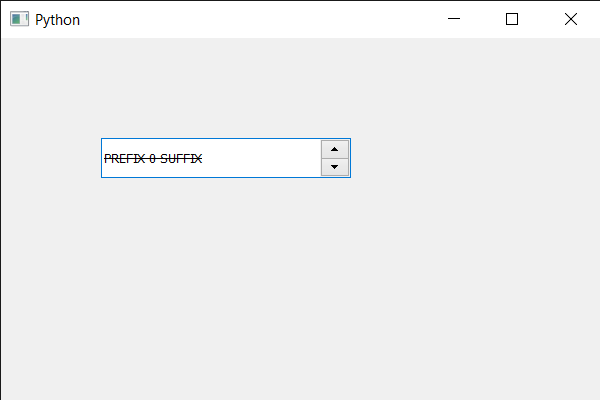En este artículo veremos cómo podemos tachar el texto del cuadro de número. Tachado/atravesado es una presentación tipográfica de palabras con una línea horizontal en el centro, lo que da como resultado un texto como este. Al contrario de los textos censurados o desinfectados, las palabras siguen siendo legibles. Esta presentación significa uno de dos significados. A continuación se muestra cómo se ve el texto tachado del cuadro de número.

Para hacer esto, usamos setStrikeOutel método con el objeto QFont del cuadro de número.
Sintaxis: font.setStrikeOut(Verdadero)
Argumento: toma bool como argumento
Retorno : Devuelve Ninguno
A continuación se muestra la implementación.
# importing libraries
from PyQt5.QtWidgets import *
from PyQt5 import QtCore, QtGui
from PyQt5.QtGui import *
from PyQt5.QtCore import *
import sys
class Window(QMainWindow):
def __init__(self):
super().__init__()
# setting title
self.setWindowTitle("Python ")
# setting geometry
self.setGeometry(100, 100, 600, 400)
# calling method
self.UiComponents()
# showing all the widgets
self.show()
# method for widgets
def UiComponents(self):
# creating spin box
self.spin = QSpinBox(self)
# setting geometry to spin box
self.spin.setGeometry(100, 100, 250, 40)
# setting range to the spin box
self.spin.setRange(0, 999999)
# setting prefix to spin
self.spin.setPrefix("PREFIX ")
# setting suffix to spin
self.spin.setSuffix(" SUFFIX")
# getting font of the spin box
font = self.spin.font()
# setting strike out
font.setStrikeOut(True)
# reassigning this font to the spin box
self.spin.setFont(font)
# create pyqt5 app
App = QApplication(sys.argv)
# create the instance of our Window
window = Window()
# start the app
sys.exit(App.exec())
Producción :
Publicación traducida automáticamente
Artículo escrito por rakshitarora y traducido por Barcelona Geeks. The original can be accessed here. Licence: CCBY-SA